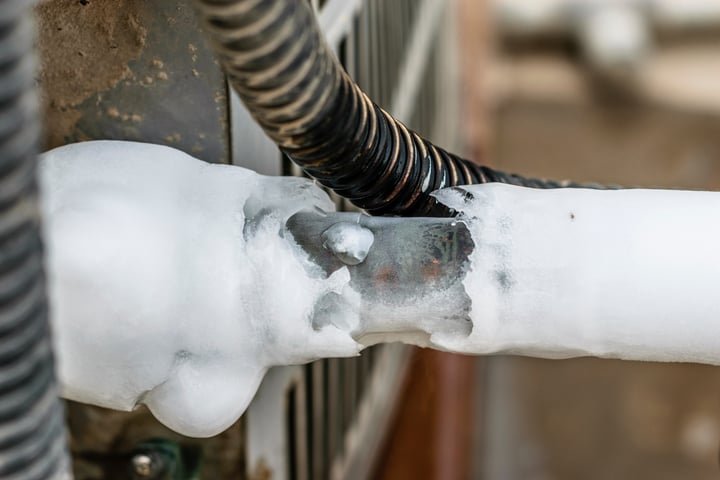How to Handle a Frozen AC Pipe - Critical Steps for Recovery
How to Handle a Frozen AC Pipe - Critical Steps for Recovery
Blog Article
Have you been in search of information on Air Conditioner Frozen? How To Fix your Frozen AC Line?

Introduction
Finding that your AC pipe is frozen can be worrying, specifically throughout hot summer season when you count on your air conditioning unit one of the most. Comprehending what to do in such a circumstance is important to stop additional damage to your air conditioning system and guarantee your comfort inside.
Understanding the Causes
A number of variables can contribute to the freezing of an air conditioner pipe. Comprehending these reasons can help you deal with the concern effectively.
Lack of Airflow
One usual reason for an icy air conditioning pipe is inadequate air movement. When the airflow over the evaporator coil is limited, it can trigger the coil to go down below freezing temperature, bring about ice formation on the pipe.
Reduced Refrigerant Levels
Insufficient cooling agent levels in your a/c system can additionally lead to a frozen pipe. Reduced cooling agent degrees can create the stress in the system to go down, bring about the cold of moisture on the evaporator coil.
Cold Weather Conditions
In chillier environments, freezing temperatures outside can add to the cold of air conditioning pipes. If your air conditioner system is not correctly shielded or if there are leaks in the ductwork, chilly air can penetrate the system, creating the pipe to ice up.
Dirty Air Filters
Dirty or stopped up air filters can limit air flow in your AC system, causing various concerns, consisting of an icy pipeline. It's necessary to change or cleanse your air filterings system routinely to guarantee appropriate air movement and avoid ice accumulation.
Indicators of a Frozen Air Conditioning Pipe
Identifying the indications of an icy a/c pipeline is essential for timely activity.
Reduced Airflow
If you notice a considerable reduction in airflow from your vents, it can show a frozen pipe.
Ice Buildup on the Pipe
Noticeable ice build-up on the refrigerant line or the evaporator coil is a clear indicator of a frozen air conditioner pipeline.
Weird Sounds from the Unit
Uncommon audios, such as hissing or bubbling, originating from your a/c device can signal that there's ice existing on the pipe.
Immediate Actions to Take
When faced with a frozen a/c pipe, it's important to act promptly to prevent further damage to your air conditioning system.
Switching off the air conditioning
The first step is to turn off your air conditioning unit to prevent the system from running and exacerbating the problem.
Checking for Blockages
Examine the area around the indoor device for any blockages that might be obstructing air flow, such as furnishings or drapes.
Thawing the Pipe
You can make use of gentle approaches like placing towels soaked in warm water around the icy pipe to assist thaw it slowly.
Preventive Measures
Taking preventive measures can help stay clear of future incidents of an icy AC pipeline.
Routine Maintenance Checks
Schedule routine maintenance get in touch with a specialist HVAC technician to make sure that your a/c system is running efficiently.
Changing Air Filters
Frequently change or clean your air filters to prevent air flow limitations and preserve optimal efficiency.
Insulating Exposed Pipes
If your air conditioning pipes are exposed to cold temperature levels, take into consideration insulating them to prevent cold during winter months.
Looking For Professional Help
If DIY techniques fall short to resolve the problem or if you're unsure concerning exactly how to proceed, it's ideal to seek aid from a qualified HVAC technician.
When DIY Methods Fail
If your attempts to thaw the pipeline or address other concerns are unsuccessful, it's time to contact a professional.
Significance of Hiring a Professional HVAC Technician
A licensed HVAC specialist has the know-how and tools necessary to diagnose and repair problems with your air conditioner system securely and successfully.
Conclusion
Dealing with a frozen air conditioning pipeline can be an aggravating experience, however knowing exactly how to react can aid reduce damage and bring back comfort to your home. By comprehending the causes, recognizing the indications, and taking prompt action, you can efficiently deal with the concern and prevent future occurrences.
What to Do If Your AC Line Is Frozen
Make Sure All Supply and Return Air Vents Are Open
If you notice problems with airflow, the first thing you should do is check your supply and return vents. Supply vents distribute clean, conditioned air throughout your home. As this air becomes stale, it’s pulled into the return vent, where it’s reconditioned before being sent back out through the supply vent.
When these vents are closed, air won’t flow in the home. Before examining your AC, check the vents in every room and ensure they’re all open.
Check for a Dirty Air Filter
Another possible cause of limited airflow is a dirty air filter. Your air conditioner’s filters catch elements you don’t want to breathe in, such as dirt and dust. Over time, filters can become clogged, ultimately blocking air from flowing in and out. The lack of airflow can then cause the entire coil to freeze and will completely restrict any air from moving through it. The AC may need to be powered off for one to two days to allow the coil to thaw after replacing the filter to allow proper functioning of the unit. This debris can also accumulate on your AC’s evaporator coil, requiring a more serious repair. In general, air filters should be cleaned regularly (about every two weeks).
Assess Your Outdoor Unit
In addition to checking your AC, assessing the outdoor unit is a good idea. Also known as the condensing unit, it works with your interior unit to release heat outside. An issue with the outdoor unit can result in rising internal temperatures.
Overgrown Shrubs or Clogged Leaves
From leaves and twigs to shrubs and debris, there’s no shortage of outdoor elements that can accumulate around your condensing unit. When these elements get lodged inside the unit, they can block airflow. Fortunately, removing the blockage can solve the problem.
Sounds of a Broken Fan
Shrubs and leaves aren’t the only things that can impede your outdoor unit’s airflow. If the fan is broken, the unit won’t be able to properly get rid of heat — which means the internal temperature won’t go down. First, make sure the fan is spinning. If it is, check for the following sounds of a broken fan:
Buzzing Rattling Screeching Hissing Clicking Preventative Measures
Nobody wants to deal with a frozen AC line. In addition to causing problems with your air conditioner, they require professional repairs. On the bright side, there are preventative measures you can take to help ensure this issue doesn’t arise in the first place.
https://www.coopergreenteam.com/blog/what-to-do-if-ac-line-frozen

Do you enjoy reading about Have a Frozen AC Line? Here’s How to Fix It? Place a remark further down. We will be pleased to hear your thinking about this blog posting. In hopes that you visit us again before long. So long as you enjoyed our blog entry kindly don't forget to share it. Thanks a bunch for your time. Come back soon.
Schedule A Service Report this page